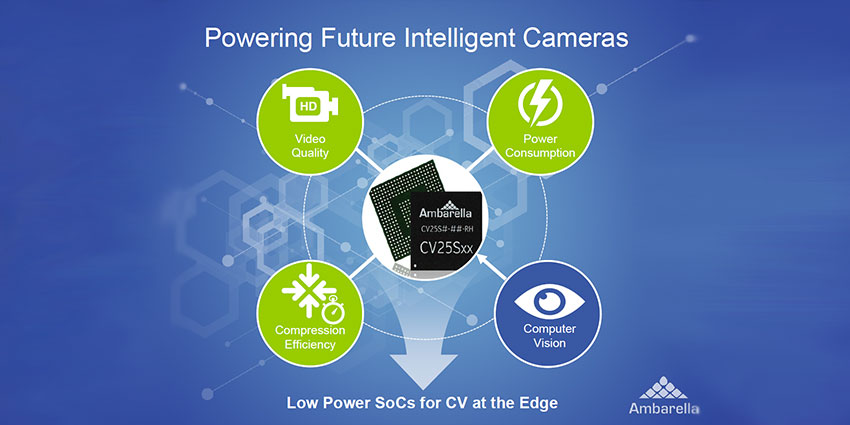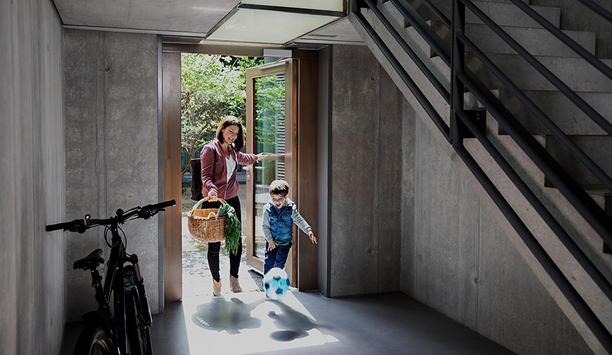Security is among the defining topics at the Consumer Electronics Show (CES) 2019 this week in Las Vegas. More than 4,500 exhibiting companies are participating, including some 1,200 startups, highlighting the next wave of innovation in consumer electronics – and security.
Twenty-four product categories at CES feature solutions to transform how consumers live, work and play. Technologies being highlighted include 5G connectivity, artificial intelligence (AI), augmented and virtual reality, smart homes, smart cities, and machine intelligence.
Video is an important element at CES. This year, the focus is on intelligent video. For example, Eyecloud.ai, Santa Clara, Calif., is displaying a home security camera with on-device face recognition that uses AI. Powered by a 12-core Intel Movidius VPU (video processing unit), the camera combines AI-on-the-edge with easy setup and wirefree operation for up to six months per battery charge.
On-device artificial intelligence
On-device AI is the next big trend in smart home surveillance, and deep neural networks will drive the future of do-it-yourself home automation
SimCam, an Intel partner, demonstrates how the Intel Movidius VPU can turn a security camera into ‘the ultimate vision-based sensor’. On-device AI is the next big trend in smart home surveillance, and deep neural networks will drive the future of do-it-yourself home automation.
A variety of other residential video systems are also on display at CES. For example, Swann Security is displaying 4K wired security systems featuring Google integration, a wireless smart security camera with True Detect heat-based PIR (photo infrared) motion detection, a video doorbell and chime with two-way talk, and indoor and outdoor wi-fi cameras with Alexa integrations.
Intelligent automotive solutions
Camera system-on-chip (SoC) company Ambarella is introducing the new CV25 camera SoC at CES. It combines advanced image processing, high-resolution video encoding and CVflow computer vision (video analytics) processing in a single, extremely low-power design. The CVflow architecture provides Deep Neural Network (DNN) processing required for a new generation of affordable and intelligent home monitoring, professional surveillance and aftermarket automotive solutions.
CV25 offers half the performance of Ambarella’s previously released CV22 chip, but the new chip’s lower cost will bring intelligent cameras to a price point desirable for home systems. All Ambarella’s chips have hardware-based cybersecurity. A suite of advanced cybersecurity features protects against hacking, including secure boot, TrustZone, and I/O virtualisation. Based on 10nm ultra-low power processing technology, the CV25 chip is optimised for wirefree cameras applications that require long battery life and small form factors.
 |
| Camera system-on-chip (SoC) company Ambarella is introducing the new CV25 camera SoC at CES |
Virtual security guards
Elsewhere, the Deep Sentinel home security system applies video and AI to predict residential break-ins ‘before they happen’. The Pleasanton, Calif.-based tech startup uses ‘AI-infused security cameras’ to keep an eye on your home. Three wireless 1080p full HD cameras provide night vision and PIR motion sensing, connected by a smart hub. Using proprietary artificial intelligence, the cameras act as virtual guards, watching activity around a house and providing alerts to situations that may lead to burglaries, break-ins, package thefts and other dangers.
My Safe Patrol is an AI-driven platform that analyses data aggregated from security personnel, citizen alert systems and IoT smart devices, and responds with geolocated alerts in real-time. My Safe Patrol effectively supports the security/safety ecosystem of a building, a campus, a city or a district through a dynamic dashboard that helps command and control operations manage and deploy security plans.
AI-integrated devices
Showcased solutions include Smart Living integration of video surveillance applications to enable real-time two-way audio and video streaming simultaneously
MicroVision, Redmond, Wash., showcases an interactive display engine for AI-connected devices, providing an integrated solution for projected display and interactivity through multi-point touch and air gestures. MicroVision’s new consumer 3D LiDAR engine provides high-fidelity spatial awareness to smart home hubs, for input to smart devices such as lighting, security, entertainment, and thermostats.
The Internet of Things (IoT) is another big topic at CES, and ThroughTek Co., Ltd., Taiwan, demonstrates IoT developments to transmit voice, video and data over both wide- and narrow-band channels in smart home applications. Showcased solutions include Smart Living integration of video surveillance applications combined with voice assistant to companion robots, wireless doorbells, and battery cameras to enable real-time two-way audio and video streaming simultaneously.
Advanced Capacitive Touchscreen
Decayeux Group, a European manufacturer of mailboxes and high security doors, is displaying MyColisBox, a secure and connected parcel box delivery system designed to provide online shoppers a secure pickup point accessible by a PIN code sent via SMS message to a smartphone. Walter is the new mobile app for MyColisBox.
Kwikset, a division of Spectrum Brands, showcases its smart lock portfolio – including three new smart locks – in the CES Smart Home Marketplace. Kwikset is showing the SmartCode 888, Kwikset Convert, Obsidian, and new designs of the SmartCode 914 and SmartCode 916, as well as a new wi-fi lock. Baldwin, Kwikset’s ‘luxury lock’ sister company, is offering a preview of its new TouchScreen Collection, launching this summer, available in five styles and featuring Advanced Capacitive Touchscreen technology.
 |
| The Internet of Things (IoT) is another big topic at CES, with many companies demonstrating IoT developments |
Cyber security standards
Privacy is increasingly a concern in the consumer space, and Private Discuss, from PIMAN Security, is a premium, secure, white label communication solution. Their active AI-powered defense architecture provides encrypted audio and video calls, messaging and file sharing. It renders a confidential, secure messaging platform that adheres to the highest standards of cybersecurity.
FLIR provides virtual reality demonstrations at their CES booth, allowing attendees to put on a virtual fire helmet and try out a FLIR camera in a real-world residential fire response scenario. Participants may also use a FLIR optical gas imaging camera virtually to stop fugitive emissions in a natural gas refinery. Booth visitors may also take “thermal selfies” to post on social media.








